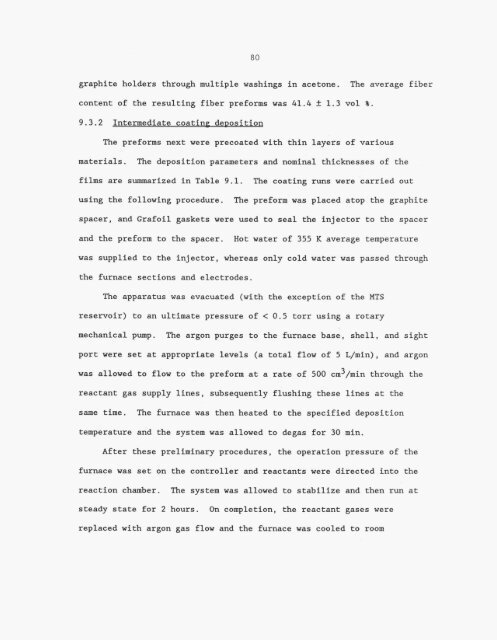Characterization and control of the fiber-matrix interface in ceramic ...
Characterization and control of the fiber-matrix interface in ceramic ...
Characterization and control of the fiber-matrix interface in ceramic ...
You also want an ePaper? Increase the reach of your titles
YUMPU automatically turns print PDFs into web optimized ePapers that Google loves.
80<br />
graphite holders through multiple wash<strong>in</strong>gs <strong>in</strong> acetone.<br />
The average <strong>fiber</strong><br />
content <strong>of</strong> <strong>the</strong> result<strong>in</strong>g <strong>fiber</strong> preforms was 41.4 f 1.3 vol %.<br />
9.3.2 Jntermediate coat<strong>in</strong>e deDositioQ<br />
The preforms next were precoated with th<strong>in</strong> layers <strong>of</strong> various<br />
materials.<br />
The deposition parameters <strong>and</strong> nom<strong>in</strong>al thicknesses <strong>of</strong> <strong>the</strong><br />
films are summarized <strong>in</strong> Table 9.1.<br />
The coat<strong>in</strong>g runs were carried out<br />
us<strong>in</strong>g <strong>the</strong> follow<strong>in</strong>g procedure. The preform was placed atop <strong>the</strong> graphite<br />
spacer, <strong>and</strong> Grafoil gaskets were used to seal <strong>the</strong> <strong>in</strong>jector to <strong>the</strong> spacer<br />
<strong>and</strong> <strong>the</strong> preform to <strong>the</strong> spacer.<br />
Hot water <strong>of</strong> 355 K average temperature<br />
was supplied to <strong>the</strong> <strong>in</strong>jector, whereas only cold water was passed through<br />
<strong>the</strong> furnace sections <strong>and</strong> electrodes.<br />
The apparatus was evacuated (with <strong>the</strong> exception <strong>of</strong> <strong>the</strong> MTS<br />
reservoir) to an ultimate pressure <strong>of</strong> < 0.5 torr us<strong>in</strong>g a rotary<br />
mechanical pump.<br />
The argon purges to <strong>the</strong> furnace base, shell, <strong>and</strong> sight<br />
port were set at appropriate levels (a total flow <strong>of</strong> 5 L/m<strong>in</strong>), <strong>and</strong> argon<br />
was allowed to flow to <strong>the</strong> preform at a rate <strong>of</strong> 500 cm3/m<strong>in</strong> through <strong>the</strong><br />
reactant gas supply l<strong>in</strong>es, subsequently flush<strong>in</strong>g <strong>the</strong>se l<strong>in</strong>es at <strong>the</strong><br />
same time. The furnace was <strong>the</strong>n heated to <strong>the</strong> specified deposition<br />
temperature <strong>and</strong> <strong>the</strong> system was allowed to degas for 30 m<strong>in</strong>.<br />
After <strong>the</strong>se prelim<strong>in</strong>ary procedures, <strong>the</strong> operation pressure <strong>of</strong> <strong>the</strong><br />
furnace was set on <strong>the</strong> <strong>control</strong>ler <strong>and</strong> reactants were directed <strong>in</strong>to <strong>the</strong><br />
reaction chamber. The system was allowed to stabilize <strong>and</strong> <strong>the</strong>n run at<br />
steady state for 2 hours.<br />
On completion, <strong>the</strong> reactant gases were<br />
replaced with argon gas flow <strong>and</strong> <strong>the</strong> furnace was cooled to room

















